Welcome to an exciting glimpse into the future of electric vehicles with Tesla’s revolutionary car battery technology. As the automotive industry moves towards sustainable and environmentally-friendly transportation options, Tesla has been at the forefront of innovation with their cutting-edge battery technology. With longer ranges, faster charging times, and increased energy efficiency, Tesla’s car batteries are paving the way for a greener tomorrow. Get ready to be amazed by the incredible advancements in electric vehicle technology that Tesla is bringing to the table. Have you ever wondered about the future of electric vehicles and how advancements in technology are shaping the way we drive? Tesla, a leading pioneer in the electric vehicle industry, has made significant strides in improving the efficiency and performance of electric vehicles through their revolutionary car battery technology. In this article, we will explore the impact of Tesla’s innovative battery technology on the future of electric vehicles.
Tesla’s Vision for the Future
You may already be familiar with Tesla’s electric vehicles, such as the Model S, Model 3, Model X, and Model Y. However, what sets Tesla apart from other car manufacturers is their vision for a future where all vehicles on the road are electric. Tesla’s mission is to accelerate the world’s transition to sustainable energy by producing electric cars, solar products, and renewable energy solutions.
Tesla’s Impact on the Electric Vehicle Market
Tesla’s influence on the electric vehicle market cannot be overstated. Not only have they disrupted the traditional automotive industry, but they have also set new standards for electric vehicles in terms of range, performance, and design. Tesla’s success has inspired other car manufacturers to invest in electric vehicle technology and develop their own electric cars.
The Importance of Battery Technology
When it comes to electric vehicles, the heart of the technology lies in the battery. Batteries are responsible for storing and supplying energy to power the electric motors that drive the vehicle. The efficiency and performance of an electric vehicle largely depend on the quality and capacity of its battery.
Challenges in Battery Technology
One of the main challenges in electric vehicle technology is the limited range of traditional batteries. Early electric vehicles had relatively short driving ranges, which made them less practical for everyday use. Additionally, the charging time for these vehicles was longer compared to refueling a gasoline-powered car.
Tesla’s Breakthrough in Battery Technology
Tesla’s breakthrough in battery technology came in the form of their proprietary battery cells, which are designed to be more energy-dense, longer-lasting, and faster-charging than traditional batteries. These advancements have allowed Tesla to increase the range of their electric vehicles, improve their performance, and reduce charging times.

The Evolution of Tesla’s Car Batteries
Tesla has been continuously improving and innovating their car battery technology since the release of their first electric vehicle. The evolution of Tesla’s car batteries has been driven by a combination of research, development, and partnerships with battery manufacturers.
Lithium-Ion Batteries
Tesla’s electric vehicles are powered by lithium-ion batteries, which are currently the most common type of rechargeable battery used in electric vehicles. Lithium-ion batteries are known for their high energy density, long cycle life, and relatively low self-discharge rate.
Battery Pack Design
One of Tesla’s key innovations in car battery technology is their battery pack design, which consists of thousands of individual battery cells arranged in modules and enclosed in a protective casing. This modular design allows Tesla to optimize the placement of batteries within the vehicle, maximize energy storage capacity, and ensure the safety of the battery pack.
Tesla’s Gigafactories
To meet the increasing demand for electric vehicles and renewable energy solutions, Tesla has invested in building Gigafactories around the world. Gigafactories are large-scale production facilities that manufacture batteries, electric vehicles, and solar products.
Advantages of Gigafactories
Gigafactories enable Tesla to scale up production, reduce manufacturing costs, and shorten supply chains. By producing their own batteries in-house, Tesla has more control over the quality, supply, and pricing of their battery cells.
Gigafactory Locations
Tesla currently operates several Gigafactories in the United States, China, and Europe, with plans to build more facilities in the future. These Gigafactories play a crucial role in Tesla’s ability to mass-produce electric vehicles, solar products, and energy storage systems.

Tesla’s Battery Day Announcement
In September 2020, Tesla held a highly anticipated event called Battery Day, where they unveiled new developments in battery technology and manufacturing. The announcements made during Battery Day have the potential to revolutionize the electric vehicle industry and accelerate the adoption of electric vehicles worldwide.
4680 Battery Cell
One of the most significant announcements from Battery Day was the introduction of the 4680 battery cell, a larger, more energy-dense battery cell that is designed to improve the performance and efficiency of Tesla’s electric vehicles. The 4680 battery cell is expected to increase range, reduce charging times, and lower production costs.
Table: Comparison of Battery Cell Sizes
| Battery Cell Size | Energy Density | Production Cost |
|---|---|---|
| 2170 | Medium | Moderate |
| 4680 | High | Low |
The Impact of Tesla’s Battery Technology on the Environment
In addition to improving the performance of electric vehicles, Tesla’s battery technology has a positive impact on the environment. By shifting away from fossil fuels and transitioning to electric vehicles powered by renewable energy sources, we can reduce greenhouse gas emissions, combat climate change, and create a more sustainable future for generations to come.
Renewable Energy Integration
Tesla’s vision for a sustainable energy future includes the integration of renewable energy sources, such as solar power and wind power, into the electric grid. By combining electric vehicles with renewable energy generation and storage, Tesla aims to create a closed-loop energy system that is environmentally friendly and energy-efficient.
Reduction in Greenhouse Gas Emissions
The widespread adoption of electric vehicles powered by clean energy sources has the potential to significantly reduce greenhouse gas emissions from the transportation sector. By switching to electric vehicles, we can decrease our reliance on fossil fuels, lower carbon emissions, and improve air quality in urban areas.
Conclusion
In conclusion, the future of electric vehicles is bright, thanks to Tesla’s revolutionary car battery technology. By continuing to innovate, invest in research and development, and expand their production capabilities, Tesla is leading the way towards a sustainable energy future. As more car manufacturers follow in Tesla’s footsteps and embrace electric vehicles, we can look forward to a world where driving is no longer a burden on the environment but a step towards a cleaner, greener future. So next time you’re on the road, remember that you too can be a part of the electric vehicle revolution.
